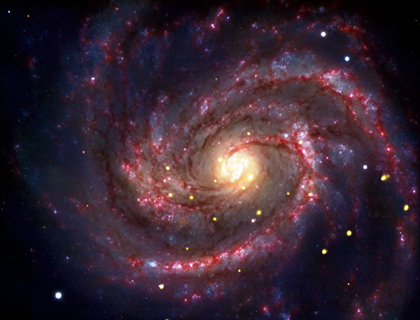For Release: November 15, 2010
CXC

Credit: X-ray: NASA/CXC/SAO/D.Patnaude et al, Optical: ESO/VLT, Infrared: NASA/JPL/Caltech
Press Image and Caption
Astronomers using NASA's Chandra X-ray Observatory have found evidence of the youngest black hole known to exist in our cosmic neighborhood. The 30-year-old black hole provides a unique opportunity to watch this type of object develop from infancy.
The black hole could help scientists better understand how massive stars explode, which ones leave behind black holes or neutron stars, and the number of black holes in our galaxy and others.
The 30-year-old object is a remnant of SN 1979C, a supernova in the galaxy M100 approximately 50 million light-years from Earth. Data from Chandra, NASA's Swift satellite, the European Space Agency's XMM-Newton and the German ROSAT observatory revealed a bright source of X-rays that has remained steady during observation from 1995 to 2007. This suggests the object is a black hole being fed either by material falling into it from the supernova or a binary companion.
"If our interpretation is correct, this is the nearest example where the birth of a black hole has been observed," said Daniel Patnaude of the Harvard-Smithsonian Center for Astrophysics in Cambridge, Mass. who led the study.
The scientists think SN 1979C, first discovered by an amateur astronomer in 1979, formed when a star about 20 times more massive than the Sun collapsed. Many new black holes in the distant universe previously have been detected in the form of gamma-ray bursts (GRBs).
However, SN 1979C is different because it is much closer and belongs to a class of supernovas unlikely to be associated with a GRB. Theory predicts most black holes in the universe should form when the core of a star collapses and a GRB is not produced.

